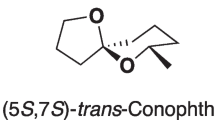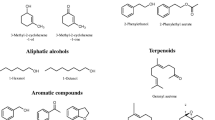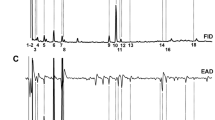Abstract
Volatiles were found to be distributed throughout adult Douglasfir beetles,Dendroctonus pseudotsugae Hopkins, suggesting that the hindgut may not be the sole site of production. The volatile content of individual beetles increased dramatically with feeding; qualitative changes reflected the different bark habitats of newly emerged and established beetles. All detected volatiles were also found in beetle frass. Myrcene was the predominant monoterpene of emergent beetles and α-pinene of fed beetles. Linalool and bornyl acetate occurred in significant amounts after feeding, and diacetone alcohol and sulcatol were also detected for the first time. The presence of sulcatol explains the reported cross-attraction withGnathotrichus spp.cis-Verbenol was also found to occur in addition totrans-verbenol. The volatile content of male beetles was similar to that of females but amounts of individual compounds were less. Acetic acid was found in both emerged and fed beetles and in lesser amounts in frass, suggesting that microbial metabolism could be a potential source of volatile production.
Similar content being viewed by others
References
Borden, J. H. 1982. Aggregation Pheromones, pp. 74–139,in J.B. Mitton and K.B. Sturgeon (eds.). Bark Beetles in North American Conifers. University of Texas Press.
Borden, J.H., Silverstein, R.M., andBrownlee, R.G. 1968. Sex pheromone ofDendroctonus pseudotsugae (Coleoptera: Scolytidae): Production, bioassay and partial isolation.Can. Entomol. 100:596–603.
Borden, J.H., Chong, L., McLean, J.A., Slesser, K.N., andMori, K. 1976.Gnathotrichus sulcatus: Synergistic response to enantiomers of the aggregation pheromone sulcatol.Science 192:894–896.
Brand, J.M., Bracke, J.W., Markovetz, A.J., Wood, D.L., andBrowne, L.E. 1975. Production of verbenol pheromone by a bacterium isolated from bark beetles.Nature 254:136–137.
Brand, J.M., Bracke, J.W., Britton, L.N., Markovetz, A.J., andBarrass, S.J. 1976. Bark beetle pheromones: Production of verbenone by a mycangial fungus of D.frontalis. J. Chem. Ecol. 2:195–199.
Brand, J.M., Schultz, J., Barrass, S.J., Edson, L.J., Payne, T.L., andHedden, R.L. 1977. Bark beetle pheromones: Enhancement ofDendroctonus frontalis (Coleoptera: Scolytidae) aggregation pheromone by yeast metabolites in laboratory bioassays.J. Chem. Ecol. 3:657–666.
Furniss, R.L., andCarolin, V.M. 1977. Western Forest Insects. USDA For. Serv. Misc. Pub. No. 273, Washington, D.C.
Furniss, M.M., Kline, L.N., Schmitz, R.F., andRudinsky, J.A. 1972. Tests of three pheromones to induce or disrupt aggregation of Douglas-fir beetles (Coleoptera: Scolytidae) on live trees.Ann. Entomol. Soc. Am. 65:1227–1232.
Furniss, M.M., Daterman, G.E., Kline, L.N., Mcgregor, M.D., Trostle, G.C., Pettinger, L.F., andRudinsky, J.A. 1974. Effectiveness of the Douglas-fir beetle antiaggregative pheromone methylcyclohexenone at three concentrations and spacings around felled host trees.Can. Entomol. 106:381–392.
Furniss, M.M., Young, J.W., Mcgregor, M.D., Livingston, R.L., andHamel, D.R. 1977. Effectiveness of controlled-release formulations of MCH for preventing Douglas-fir beetle (Coleoptera: Scolytidae) infestation in felled trees.Can. Entomol. 109:1063–1069.
Hughes, P.R. 1973.Dendroctonus: Production of pheromones and related compounds in response to host monoterpenes.Z. Angew. Entomol. 73:294–312.
Kinzer, G.W., Fentiman, A.F., Jr., Page, T.F., Jr., Foltz, R.L., Vité, andPitman, G.B. 1969. Bark beetle attractants: Identification, synthesis and field bioassay of a new compound isolated fromDendroctonus.Nature 221:477–478.
Kinzer, G.W., Fentiman, A.F., Jr., Foltz, R.L., andRudinsky, J.A. 1971. Bark beetle attractants: 3-Methyl-2-cyclohex-1-one isolated fromDendroctonus pseudotsugae.J. Econ. Entomol. 64:970–971.
Libbey, L.M., Morgan, M.E., Putnam, T.B., andRudinsky, J.A. 1976. Isomer of antiaggregative pheromone identified from male Douglas-fir beetle: 3-Methylcyclohex-3-en-1-one.J. Insect. Physiol. 22:871–873.
Libbey, L.M., Ochlschlager, A.C., andRyker, L.C. 1983. 1-methylcyclohex-2-en-1-ol as an aggregation pheromone ofDendroctonus pseudotsugae.J. Chem. Ecol. 9(12): 1533–1541.
Libbey, L.M., Ryker, L.C., andYandell, K.N. 1985. Laboratory and field studies of volatiles released byDendroctonus ponderosae Hopkins.Z. Angew. Entomol. 100:381–391.
Pitman, G.B. 1973. Further observations on Douglure in aDendroctonus pseudotsugae management system.Environ. Entomol. 2:109–112.
Pitman, G.B., andVité, J.P. 1970. Field response ofDendroctonus pseudotsugae (Coleoptera: Scolytidae) to synthetic frontalin.Ann. Entomol. Soc. Am. 63:661–664.
Renwick, J.A.A., andHughes, P.R. 1975. Oxidation of unsaturated cyclic hydrocarbons byDendroctonus frontalis.Insect. Biochem. 5:459–463.
Ringold, G.B.,Gravelle, P.J.,Miller, D.,Furniss, M.M., andMcGregor, M.D. 1975. Characteristics of Douglas-fir beetle infestation in northern Idaho resulting from treatment with Douglure. USDA For. Serv. Res. Note INT-189, 10 pp.
Rudinsky, J. A., andDaterman, G.E. 1964. Field studies on flight patterns and olfactory responses of ambrosia beetles in Douglas-fir forests of western Oregon.Can. Entomol. 96:1339–1352.
Rudinsky, J.A., andRyker, L.C. 1980. Multifunctionality of Douglas-fir beetle pheromone 3,2-MCH confirmed with solvent dibutyl phthalate.J. Chem. Ecol. 6:193–201.
Rudinsky, J.A., Kinzer, G.W., Fentiman, A.F., Jr., andFoltz, R.L. 1972. trans-Verbenol isolated from Douglas-fir beetle: Laboratory and field bioassay in Oregon.Environ. Entomol. 1:485–488.
Rudinsky, J.A., Morgan, M.M., Libbey, L.M., andMichael, R.R. 1973. Sound production in Scolytidae: 3-Methyl-2-cyclohexen-1-one released by the female Douglas-fir beetle in response to male sonic signal.Environ. Entomol. 2:505–509.
Ryker, L.C., Libbey, L.M., andRudinsky, J.A. 1979. Comparison of volatile compounds and stridulation emitted by the Douglas-fir beetle from Idaho and western Oregon populations.Environ. Entomol. 8:789–798.
Vité, J.P., Pitman, G.B., Fentiman, A.F., Jr., andKinzer, G.W. 1972. 3-Methyl-2-cyclohexen-1-ol isolated fromDendroctonus.Naturwissenschaften 50:469.
Zenther-Moller, O., andRudinsky, J.A. 1967. Studies on the site of pheromone production inDendroctonus pseudotsugae (Coleoptera: Scolytidae).Ann. Entomol. Soc. Am. 60:575–582.
Author information
Authors and Affiliations
Rights and permissions
About this article
Cite this article
Madden, J.L., Pierce, H.D., Borden, J.H. et al. Sites of production and occurrence of volatiles in Douglas-fir beetle,Dendroctonus pseudotsugae hopkins. J Chem Ecol 14, 1305–1317 (1988). https://doi.org/10.1007/BF01019354
Received:
Accepted:
Issue Date:
DOI: https://doi.org/10.1007/BF01019354




